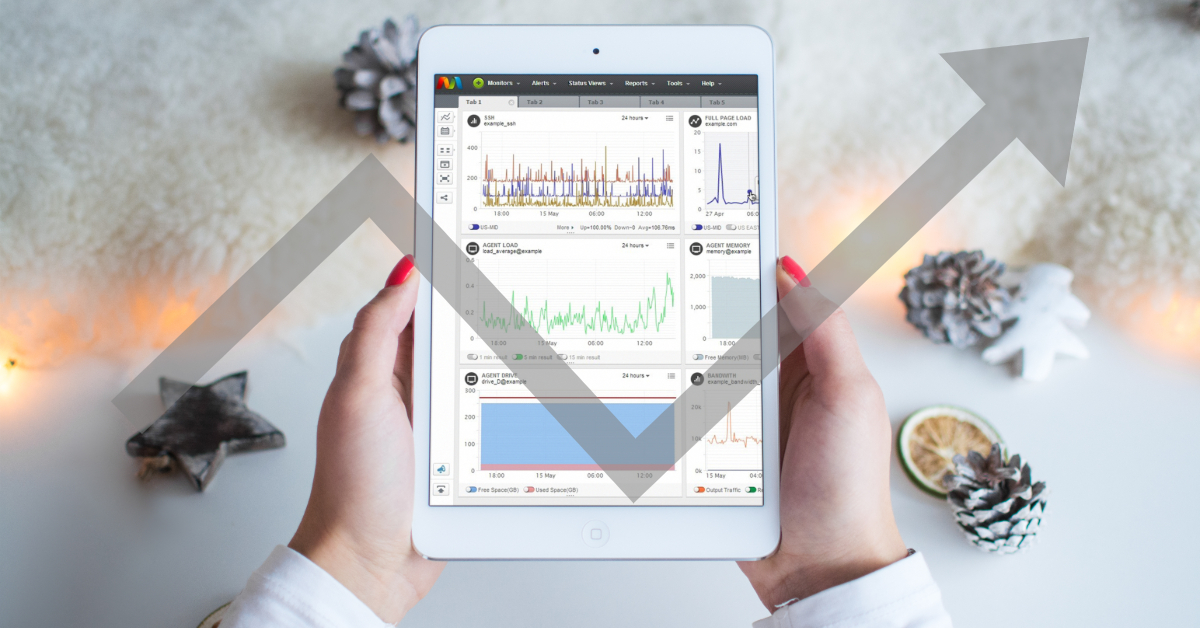06 Jul

As Black Friday, Cyber Monday, and Christmas approach, you need to make sure that your web page is ready to handle high traffic and customer requests. During holidays, online shopping platforms have 3 times more traffic than usual. It means that now your web resource performance is more important than ever. Most internet customers expect less than two seconds of load time for web pages. When your clients are satisfied with web page speed, they are more likely to register and make a deal. Regardless if you have a web page, online shop or SaaS, to provide your service without interruptions, you need to know your web page’s health status; in other words, you need to have a website monitoring system.
What is that?
Web performance monitoring is the combination of checking web site or web application performance, load, functionality and availability. It allows you to be safe and sure that your online store, or other platform, is always available with efficient performance, and your users don’t suffer unexpected downtime.
Why is web performance monitoring so important?
According to Tammy Everts’ book “Time Is Money”, the speed at which web pages and web applications perform is perceived as a major business issue. While this awareness lags in some parts of the world more than others, what is certain is that internet users are very aware of the issue of poor website performance, regardless of their geological location.
If web page initial load time will be more that 3-4 seconds, about 22.5% of users will leave your page.
According to “1&1 Internet company researches. 2011“, based on a survey which questioned 1500 internet users; those who experience a 2 second slowdown in page loads are usually unhappy with page performance and simply do less on that page. They report being less satisfied with their overall experience and then they tell their friends and colleagues about the poor page performance. About 78% of online users felt negative emotions because of slower or broken web pages, and nearly 70% of online users felt regularly inconvenienced by slow websites.
Last year, we researched and checked some of the most famous e-commerce stores during the holiday season. Here are some details from our research.

Average load time by store
TOP 5 stores with the best full-page load time and TOP 5 stores with the worst full-page load time.

TOP 5 Best and Worst full-page load times
As we can see from both uptime and full-page reports: most e-commerce web stores were ready for holidays, and their pages were mostly up. But we can also see that page load time had increased, which is not a good indicator. If they do not periodically monitor their stores, they can lose potential customers because of high page load time.
So, what type of website monitoring can you use?
Web page uptime monitoring
Web page uptime monitoring is for the regular checkup of response time and availability of your web page from different geological locations. It is very important for every business. If your web page is down, it means that your business is also not accessible on the internet. Your clients will be dissatisfied or, even worse, will move to your competitors’ sites. You should be one of the first people to be informed about any issue connected to your web site, so you can react as soon as possible. There are many tools available for web page performance monitoring. One of the most reliable tools is Scopify.

Web page uptime view example from all locations
Scopify is one of the most stable tools, with 99.99% average uptime rate. This tool has about 32 geological locations with appropriate servers that can check your web site uptime 24/7, starting every 1 minute using different protocols like: HTTP, HTTPS, DNS, PING, TCP and etc.
Web page full load monitoring
As mentioned earlier, if your page load time is more than 3-4 seconds, about 22.5 % of users will leave your site. There are many factors that can affect people’s perception of time, especially age, emotions, location, culture, etc.
Personal inconsistencies can certainly have a huge impact on our online experience as well:
The average web page user perceives load times as being 15% slower than it is. Later, while recalling the experience, they remember load time as being 35% slower.
The average person believes that they spend about nine minutes per day waiting for slow web pages.
This problem can be solved with the help of some indicators, namely adding some spinners, progress bars, pre-loads and spinning wheels. Thanks to the mentioned indicators, an illusion is created in our minds that that pages are about 10% faster than they really are.
You can monitor your page more effectively if you have “Full Page Monitoring”. With the help of full page load monitoring, you will get full page load time information for each hour of the day. This kind of monitor shows all resources which are loading during page load. You can see which resources are causing failure when a page is not loading during an expected period.

Network resources view of full page load monitor.
Transaction Monitoring
Another important metric is web page functionality. This is especially relevant for online trade platforms or online shops which must be available 24/7. Your users certainly will do the following actions: visit your web page, register, login with their usernames and passwords (or just surf the market as a guest user), choose some products, add some items to the shopping cart, and pay for them using one of your integrated payment systems. In case one of these processes is not completed successfully, your clients will not be able to buy items from your store and you will lose both the money and customer.
So, what can you do to avoid such a scenario?
You could periodically open your page and perform the same exact actions as your users. However, it will take up too much time and it will be unbelievably boring. Instead, you can use “Synthetic Transaction” monitoring.
Synthetic transaction monitoring uses a predefined script which performs the same actions as your users. You can easily record a script with a transaction recorder and then set up a monitor which will use the created script. If you need help with scripts, you can turn to the Scopify Support team, and they will create and integrate the script for you within two days.
The script will perform steps, one by one, and check the metrics of each one. You can separate step load time, and if time is higher than expected, the monitor will send you an alert. In the alert message you will see all needed information: at which step the script failed, cause of failure, and the screenshot of your page the moment the problem occurred. In short, you will be immediately informed if your page or one of the steps does not perform properly. This monitoring allows you to run the script starting every five minutes. Different geological locations are also available for this type of monitoring, meaning you can run the transaction script from different regions.
Conclusion
Your site is an organic entity that needs constant care to stay performant. My greatest hope in writing this article is that I’ve helped motivate you to embrace performance as an evergreen project and to celebrate the influences of performance wins on your business.
Sure, implementing one of the mentioned monitoring options is better than implementing none, but the goal is to make your web page so great that users would want to come back and spend their money. Website monitoring will help you be safe of any unusual behavior. Your customer success rate will be high, and you will not lose money because of web poor web page performance.
In what other ways can you make your web page performance great?


